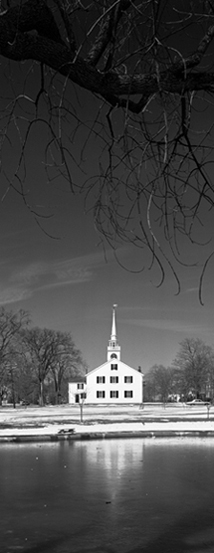
"The images in this book are astonishing. Their subjects are the iconic, 18th and 19th century structures that were once the center of community life in the region and still define the New England landscape today. Rosenthal gives them an epic stature. Through the sensitivity of his compositions, these frail wooden barns - indeed they were built mostly for farmers - become heroic, timeless architecture.
In these photographs, the reader will find a full education in architecture. Here are essays on siting, context, and urbanism. Here are essays on the efficiency of form as it relates to function, on the use of daylight and sun, and on the role of structure. These photographs are essays in style, and how style carries meaning."
John Tittmann, Architect, Review of White on White in ArchitectureBoston, Fall 2010
"If you expect monotony from this book - misled, perhaps, by its tongue-in-cheek title - then you will be disappointed. These images show a range of tones from lightest white to darkest black, plus every shade of gray - all the pigments in the palette of a master black-and-white photographer.
In photographs made over a span of 45 years, Steve Rosenthal does for the supposedly simple New England meetinghouse what Ansel Adams did for Yosemite: He rediscovers, revisualizes, and anchors it firmly in our visual memory.
...Steve Rosenthal's images are the kind over which the hungry eye, famished for aesthetic and intellectual nourishment, will want to roam again and again. Should your own coffee table have the good fortune to be the field of such happy visual grazing, it should feel abundantly blessed."
Larry Sommers, Editor, The Conregationalist, Review of White on White, June 2010
"I see these images as meditations. They are so still. I wondered if the moments and spaces captured were real. A fleeting survey of these images will not do them justice; they are so quiet and almost too perfectly beautiful. One has to still one's self to appreciate them."
Tony Decaneas, Panopticon Gallery, Boston, Massachusetts
"I have just finished my first "reading" of your book. It is spectacular: beautiful, insightful, timeless. In a stroke, you have become the conscience of these New England icons, their steward."
Brett Donham, Architect, and Chair, Episcopal Divinity School, Cambridge, Massachusetts
"... a sense of loss hangs heavily over some of these images, while others reveal a vitality that will surely endure for centuries to come. Look closely at these images and you will discover that they capture more than the spirit of the places they document. They also capture the spirit of the gifted photographer who made them."
Elizabeth Padjen FAIA, Editor, ArchitectureBoston
"We showed samples of this work about 18 months ago and feel the work, and the book, are among the most noteworthy and beautifully done projects by a large format photographer in many years."
"We received a copy of your book at the Congregational Library this past week, and are absolutely smitten with it. It truly does capture the spirit of the churches whose history we are preserving here."
Margaret Bendroth, Executive Director, Congregational Library of the American Congregational Association, Boston, Massachusetts
"The book is perfection, the photographs are perfect. After a couple of hours I felt so calm and happy to have had a perfect experience.
"It's almost as if the churches aren't real life anymore but a remembered time, an unreal, pristine time that is lost forever. And we must preserve the churches to have that remembered time."
Sylvia Steiner, Former Design Director, MIT Press, Yale Press
"I opened the book, STUNNING, and everyone has marveled at [it]. We had quite a crowd here this past weekend, and again your book has blown people away. A magnificent book! Will make a great great exhibition too.... The scale, and the design, choice of paper/printing combined with your stately imagery make a fantastic experience for the viewer."
Mary Virginia Swanson, Tucson, Arizona
"What makes photography interesting is that every good photographer sees and presents a different world. Steve's DNA as a photographer was an understanding of architectural space. Where another photographer might be more interested in effects of light, let's say, or in abstract patterns, Steve always seemed best at capturing the three-dimensional quality of a space. You always felt you could inhabit his photographs.
...In these photos, Steve is certainly a master of what I just called effects of light and abstract patterns. But he rarely fails to place his image in a suggestion of architectural space. And because there are no human figures, the windows, the headstones, and the facades of these churches become, like mimes in white, silent actors in Steve's unique artistic achievement."
Robert Campbell, Architect, Cambridge, Massachusetts, and Pulitzer Prize winning architure critic for the Boston Globe
